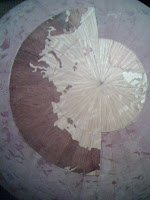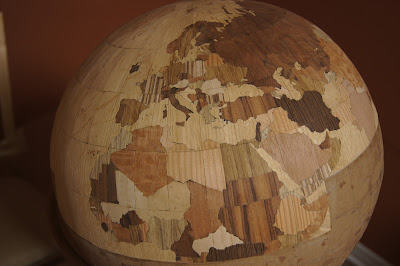So I decided to build a globe. After figuring out the
maps, the next step was working out the structure of the globe itself. My general plan is to glue wood veneer onto the surface of a sphere, so obviously the first thing I need is a reasonably sized sphere. I wanted my globe to be relatively large, on the order of 16 to 18 inches in diameter.
My first thought was a sphere made of wood. It
turns out that making a wooden sphere of this size is an art in itself. While you may be able to buy a wooden sphere, a large one wouldn't be cheap. I considered
plastic, but was worried about how glue would work on that kind of surface.
I eventually decided to make a sphere myself using fiberglass. So I went down to the toy store, bought a 16" diameter red rubber ball, and covered it in fiberglass cloth and
epoxy resin with a structural filler.
 |
| The ball had Spider-man on it. |
To support the globe, I bought
bearings and a
3/8" brass rod. I cut the globe in half and removed the remnants of the rubber ball. Then I mounted the bearings in blocks of wood at the north and south poles.
 |
| Spider-man left his mark. |
 |
| North pole is at the bottom of the photo. |
The bearing at the north pole is entirely internal to the globe. The bearing at the south pole where the supporting rod enters will be the only opening in the globe. Gluing the halves back together with some more epoxy and filler leaves us with a sphere free to rotate on its axis.















